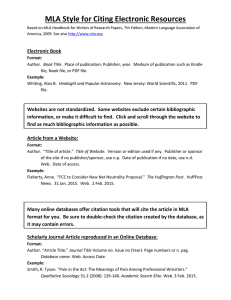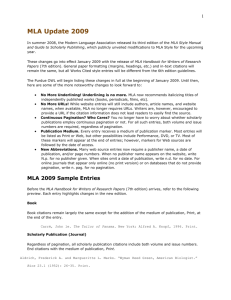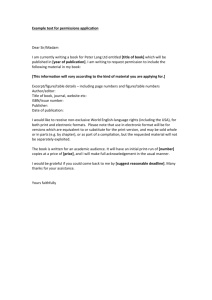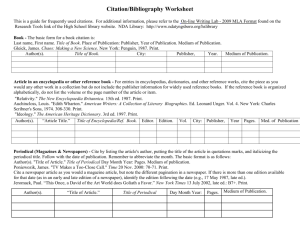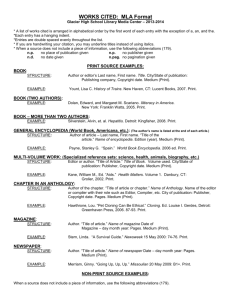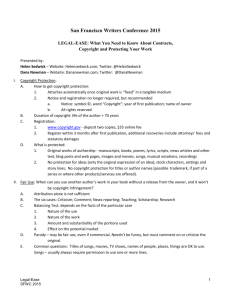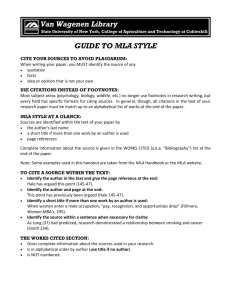MLA Style for the List of Works Cited
advertisement
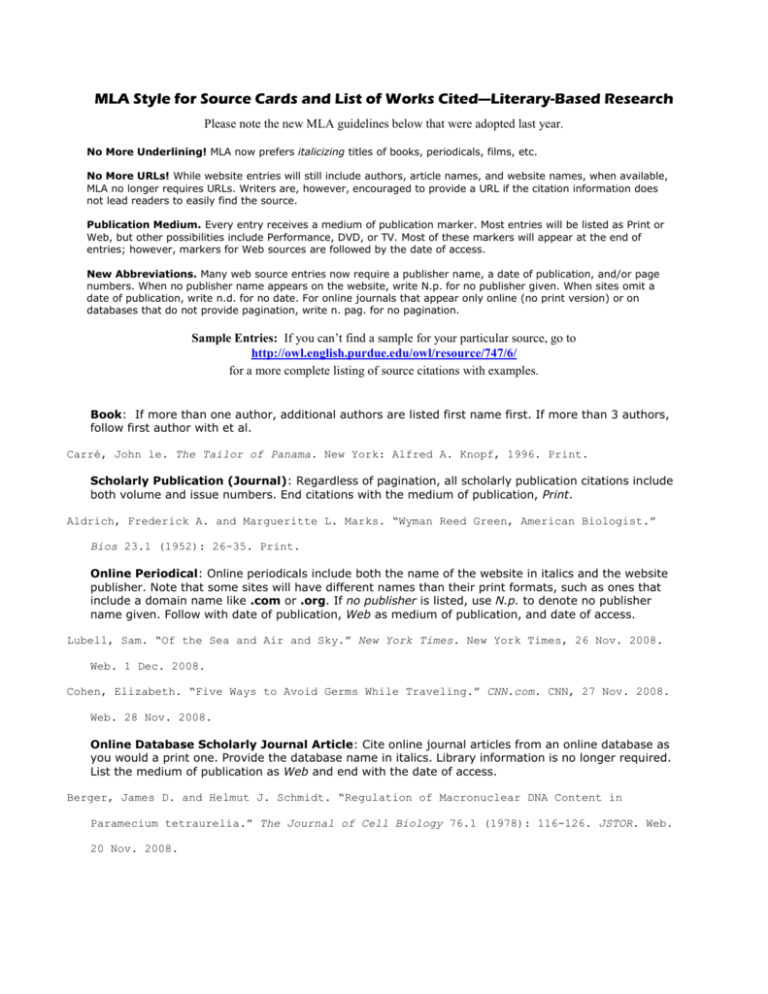
MLA Style for Source Cards and List of Works Cited—Literary-Based Research Please note the new MLA guidelines below that were adopted last year. No More Underlining! MLA now prefers italicizing titles of books, periodicals, films, etc. No More URLs! While website entries will still include authors, article names, and website names, when available, MLA no longer requires URLs. Writers are, however, encouraged to provide a URL if the citation information does not lead readers to easily find the source. Publication Medium. Every entry receives a medium of publication marker. Most entries will be listed as Print or Web, but other possibilities include Performance, DVD, or TV. Most of these markers will appear at the end of entries; however, markers for Web sources are followed by the date of access. New Abbreviations. Many web source entries now require a publisher name, a date of publication, and/or page numbers. When no publisher name appears on the website, write N.p. for no publisher given. When sites omit a date of publication, write n.d. for no date. For online journals that appear only online (no print version) or on databases that do not provide pagination, write n. pag. for no pagination. Sample Entries: If you can’t find a sample for your particular source, go to http://owl.english.purdue.edu/owl/resource/747/6/ for a more complete listing of source citations with examples. Book: If more than one author, additional authors are listed first name first. If more than 3 authors, follow first author with et al. Carré, John le. The Tailor of Panama. New York: Alfred A. Knopf, 1996. Print. Scholarly Publication (Journal): Regardless of pagination, all scholarly publication citations include both volume and issue numbers. End citations with the medium of publication, Print. Aldrich, Frederick A. and Margueritte L. Marks. “Wyman Reed Green, American Biologist.” Bios 23.1 (1952): 26-35. Print. Online Periodical: Online periodicals include both the name of the website in italics and the website publisher. Note that some sites will have different names than their print formats, such as ones that include a domain name like .com or .org. If no publisher is listed, use N.p. to denote no publisher name given. Follow with date of publication, Web as medium of publication, and date of access. Lubell, Sam. “Of the Sea and Air and Sky.” New York Times. New York Times, 26 Nov. 2008. Web. 1 Dec. 2008. Cohen, Elizabeth. “Five Ways to Avoid Germs While Traveling.” CNN.com. CNN, 27 Nov. 2008. Web. 28 Nov. 2008. Online Database Scholarly Journal Article: Cite online journal articles from an online database as you would a print one. Provide the database name in italics. Library information is no longer required. List the medium of publication as Web and end with the date of access. Berger, James D. and Helmut J. Schmidt. “Regulation of Macronuclear DNA Content in Paramecium tetraurelia.” The Journal of Cell Biology 76.1 (1978): 116-126. JSTOR. Web. 20 Nov. 2008. Galileo Example: Be sure to list specific name of the database that you are using EBSCOhost is the name of a vendor of numerous databases. You will need to list the specific database you use, such as Academic Search Premier or Professional Development Collection. Caminero-Santagelo, Byron. “A Moral Dilemma: Ethics in Tess of the D’Ubervilles.” English Studies 75.1 (1994): 46 Academic Search Premier. GALILEO. Web. 26 Aug. 2003. Gale Example Heinegg, Peter. "You Still Can't Get There from Here." America 187.12 (21 Oct. 2002): 26. Contemporary Literary Criticism. Gale Group. Web. 26 May 2009. Online-only Publication: For articles that appear in an online-only format or in databases that do not provide a page number, use the abbreviation n. pag. for no pagination. End the citation with the medium of publication, Web, and the date of access. Kessl, Fabian and Nadia Kutsche. “Rationalities, Practices, and Resistance in PostWelfarism. A Comment on Kevin Stenson.” Social Work & Society 6.1 (2008): n. pag. Web. 10 Oct. 2008. A Previously Published Work in a Literature Anthology Chopin, Kate, “The Story of an Hour.” 1894. Prentice Hall Literature: The American Experience. Eds. Kinsella, Kate, et. al. Upper Saddle River: Prentice Hall, 2005. 634638. Print. Other Material in a Literature Anthology “Prosperity and Protest (1946-Present): Literature of the Period.” Prentice Hall Literature: The American Experience. Eds. Kinsella, Kate, et. al. Upper Saddle River: Prentice Hall, 2005. 962. Print. An Article in a Reference Book Durgin, Frank H. “Visual Adaptation.” Encyclopedia of Psychology. Ed. Alan E. Kazdin. Vol. 8. New York: Oxford, 2000. 183-187. 8 vols. Print. Twentieth Century or Contemporary Literary Criticism (the hardcover TCLC or CLC books) Holladay, Hillary. “Narrative Space in Ann Petry’s Country Place.” Xavier Review 16 (1996): 21-35. Rpt. in “Raymond Carver.” Twentieth Century Literary Criticism. Eds. Linda Pavlovski and Scott Darga. Vol. 112. Detroit: Gale, 2002. 356-62. Print. A Television or Radio Program “Frankenstein: The Making of the Monster.” Great Books. Narr. Donald Sutherland. Writ. Eugenie Vink. Dir. Jonathan Ward. The Learning Channel. 8 Sept. 1993. TV. “Shakespearean Putdowns.” Narr. Robert Siegel and Linda Wertheimer. All Things Considered. Natl. Public Radio. WVIA, Pittston, PA. 6 Apr. 1994. Radio.
